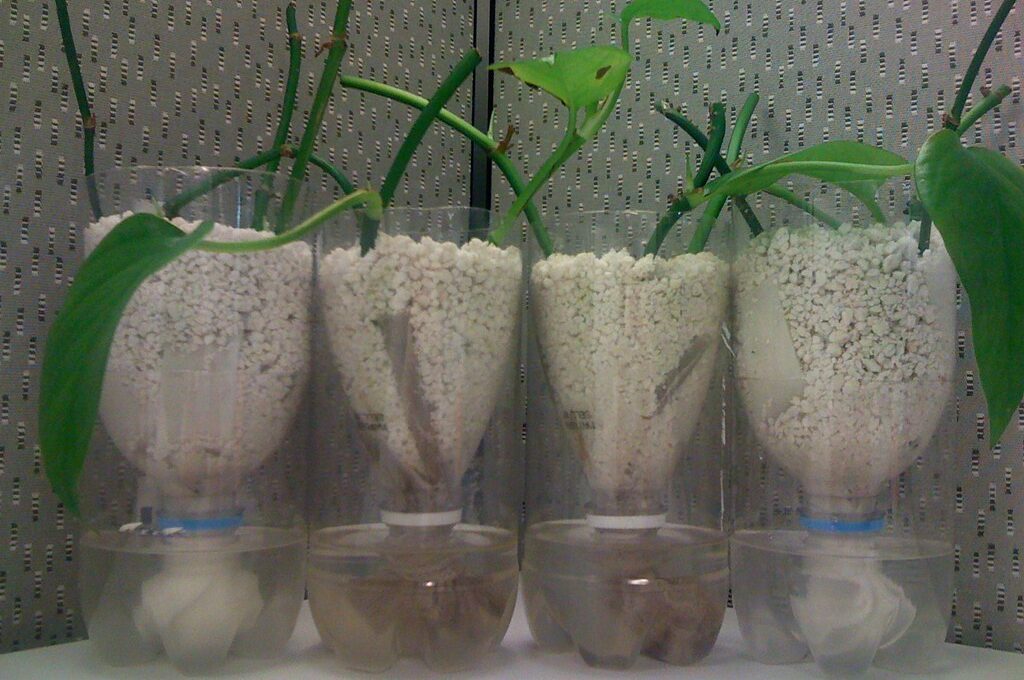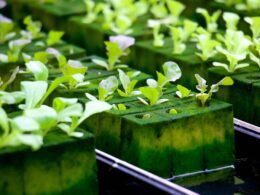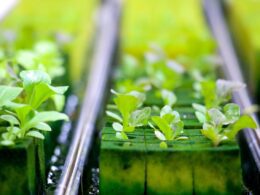Are you considering starting a hydroponic system? Before you dive in, it’s important to understand the root problems that can arise when growing plants hydroponically.
Hydroponics is an innovative method of growing plants without soil, using water and nutrient solutions instead. While this technique has many benefits, it can also present unique challenges that must be addressed to ensure the success of your hydroponic garden.
One of the most significant challenges in hydroponics is nutrient solution management. Unlike traditional gardening, where soil provides a natural buffer for plants, hydroponic systems require precise control over the nutrient solution to ensure that plants receive the correct balance of nutrients.
This can be challenging for beginners, who may struggle to maintain the correct pH level and nutrient concentrations. However, with the right knowledge and tools, nutrient solution management can be mastered, allowing you to grow healthy and vibrant plants in your hydroponic system.
Nutrient Solution Management
Managing the nutrient solution is crucial for success in hydroponic growing – it’s like the lifeblood of your plants!
One of the main problems in hydroponics is maintaining the correct pH balance of the nutrient solution. The pH level can affect the availability of nutrients to your plants, so it’s important to regularly check and adjust the pH level of your solution. Ideally, the pH level should be between 5.5 and 6.5 for most plants.
Another issue with nutrient solution management is maintaining the correct nutrient concentration. If the concentration is too weak, your plants won’t receive enough nutrients to grow properly. On the other hand, if the concentration is too strong, it can lead to nutrient burn and damage to your plants. It’s important to follow the recommended feeding schedule for your specific plants and adjust the nutrient solution accordingly.
Regularly monitoring and adjusting the pH balance and nutrient concentration of your hydroponic system is essential for healthy plant growth. Neglecting these factors can lead to stunted growth, nutrient deficiencies, and even plant death. By staying on top of these issues and providing your plants with the proper care, you can ensure a successful hydroponic harvest.
Pest and Disease Control
You’ll need to keep a watchful eye on sneaky pests and pesky diseases that can creep into your hydroponic setup like unwelcome guests at a party. Integrated pest management is the key to keeping your plants healthy and pest-free. Here are four things you can do to keep pests and diseases under control:
-
Monitor your plants regularly for signs of pest infestations or disease. Look for wilting, yellowing, or spotted leaves, as well as any unusual growths or discolorations.
-
Use natural remedies like neem oil, insecticidal soap, and beneficial insects to control pests. These methods are safer for your plants and the environment than harsh chemical pesticides.
-
Keep your hydroponic system clean and well-maintained to prevent the buildup of algae, bacteria, and other harmful organisms.
-
Choose disease-resistant crops whenever possible. These plants are less susceptible to common diseases and will be easier to manage in the long run.
By following these tips, you can stay ahead of any potential pest or disease problems in your hydroponic garden. Remember, prevention is the best medicine. By taking a proactive approach to pest and disease control, you can ensure that your plants stay healthy and strong, and that your hydroponic setup remains a safe and productive space for years to come.
Water Quality and Maintenance
Make sure to keep an eye on the quality and maintenance of your water to ensure that your plants thrive and stay healthy in your hydroponic garden. Water is the lifeblood of your plants, and any issues with its quality or maintenance can have a significant impact on their growth and development. One of the most crucial aspects of water quality is testing, which can help you identify any potential problems before they become too severe.
pH monitoring is another critical aspect of water quality in hydroponics. The pH level of your water can have a significant impact on your plants, as it affects their ability to absorb nutrients and grow. You should aim for a pH level between 5.5 and 6.5, as this range is optimal for most plants. Regular testing and adjustments to your pH level can help ensure that your plants get the nutrients they need to thrive.
Maintaining the quality of your water also involves regular maintenance, such as changing the water and cleaning your system. Dirty water can lead to the growth of harmful bacteria and algae, which can damage your plants. By following a regular maintenance schedule, you can ensure that your water remains clean and healthy for your plants. Remember, keeping a close eye on your water quality and maintenance is crucial to the success of your hydroponic garden.
| Potential Water Quality Issues | Solutions | |||
|---|---|---|---|---|
| Algae growth | Regular cleaning and maintenance | |||
| pH imbalance | Regular water testing and adjustment | |||
| Nutrient deficiencies | Adjusting nutrient levels and monitoring plant health | |||
| Contaminants | Water filtration and purification systems | Temperature fluctuations | Installing a temperature control system or adjusting the environment |
Lighting and Temperature Control
To get the most out of your hydroponic garden, it’s important for you to understand how lighting and temperature control can impact the growth and health of your plants.
Light source selection is crucial when it comes to hydroponics. You need to choose the right type of light source for your plants, as different plants have different light requirements. LED lights are the most popular choice for hydroponic gardens, as they’re energy-efficient, long-lasting, and provide the full spectrum of light that plants need.
Temperature regulation techniques are also important to consider when setting up your hydroponic garden. Your plants need a consistent temperature that’s within their ideal range. This means you need to keep a close eye on the temperature of your grow room and adjust it accordingly. You can use techniques such as ventilation, air conditioning, and heating to regulate the temperature.
It’s also important to monitor the humidity levels in your grow room, as this can affect the temperature and the health of your plants.
Overall, lighting and temperature control are two critical factors that can make or break your hydroponic garden. By selecting the right light source and regulating the temperature, you can ensure that your plants grow healthy and strong. Keep in mind that each plant has different light and temperature requirements, so it’s essential to do your research and adjust accordingly.
With the right setup and maintenance, your hydroponic garden can flourish and provide you with fresh, healthy produce all year round.
Sustainability and Future Development
You may be interested to know about the advantages of hydroponics for sustainable agriculture. The technology has the potential to conserve water, reduce pesticide use, and increase crop yields. However, it also faces challenges that need to be addressed for future development. These include issues such as energy consumption and nutrient management.
Collaborative efforts between scientists, farmers, and industry professionals can help to overcome these challenges and further advance the field of hydroponics. Working together, they can drive research and innovation to create more efficient and sustainable hydroponic systems. So, if you’re interested in sustainability and future development, keep an eye on the exciting developments in hydroponics!
Advantages of Hydroponics for Sustainable Agriculture
Using hydroponic systems has several benefits for promoting sustainable agriculture. One of the advantages is that it allows for vertical farming, which means you can grow more crops in a smaller area. This is especially useful for urban agriculture, where space is limited.
Hydroponic systems also use less water than traditional farming methods, which is a crucial factor in areas where water is scarce. By using nutrient-rich water solutions, hydroponic systems can grow crops faster and with less water, making it a more sustainable option for agriculture.
Another benefit of hydroponic systems is that they allow for year-round crop production. With climate change affecting traditional farming methods, hydroponic systems provide a more reliable and consistent way to grow crops. They also eliminate the need for pesticides and herbicides, creating a healthier and safer environment for both the crops and the farmers.
By utilizing hydroponic systems, farmers can produce high-quality crops with less waste and a lower carbon footprint, making it a more sustainable option for the future of agriculture.
Challenges and Opportunities for Future Development
As you explore the challenges and opportunities for future development in sustainable agriculture, you’ll discover that hydroponics has some limitations that need to be overcome.
One of the main challenges in hydroponics is the high initial cost of setting up the system. This can be a major barrier for small-scale farmers who may not have the resources to invest in expensive equipment. However, future innovations in technology and design can help to reduce these costs and make hydroponics more accessible to everyone.
Another limitation of hydroponics is the need for a consistent supply of nutrients and water. In traditional soil-based agriculture, plants can draw on a wide range of nutrients from the soil, but in hydroponics, the grower has to carefully monitor and adjust the nutrient solution to ensure that the plants are getting everything they need. However, this also presents an opportunity for future innovation, as new technologies can be developed to make it easier to maintain a consistent nutrient balance and reduce the risk of nutrient deficiencies or excesses.
With continued research and development, hydroponics has the potential to revolutionize how we grow our food and create a more sustainable future for everyone.
Collaborative Efforts in Hydroponics Research and Innovation
Let’s take a look at how innovation partnerships and cross-disciplinary teams are shaping the future of hydroponics. These collaborative efforts are bringing together experts from various fields to explore new possibilities in sustainable agriculture.
Here are three ways in which these partnerships are making a difference in hydroponics research and development:
-
Sharing knowledge: By working together, researchers and innovators are sharing their knowledge and expertise, which can lead to new discoveries and breakthroughs in hydroponic agriculture.
-
Joint funding: Collaborative efforts often involve joint funding from multiple sources, which can help to accelerate research and development and make it more efficient.
-
Cross-disciplinary teams: Hydroponics research and development involves a wide range of fields, including biology, engineering, and agriculture. By bringing together experts from these fields, cross-disciplinary teams can work together to solve complex problems and develop new technologies.
With these collaborative efforts, we can expect to see continued innovation and progress in hydroponics, ultimately leading to more sustainable and efficient agricultural practices.
Frequently Asked Questions
What are the most common mistakes made in hydroponic nutrient solution management?
When it comes to hydroponics, one of the most common mistakes is improper nutrient solution management.
Nutrient solution optimization is key to ensuring that your plants receive the proper nutrients they need to thrive. This involves monitoring the pH and EC levels of your solution regularly and making adjustments as needed to ensure optimal plant uptake efficiency.
Neglecting to do so can lead to nutrient deficiencies or toxicities, which can harm or even kill your plants. By taking the time to properly manage your nutrient solution, you can ensure that your plants are healthy and thriving.
How can I prevent pest and disease issues in my hydroponic system?
To prevent pest and disease issues in your hydroponic system, integrate beneficial insects and use chemical-free methods. Beneficial insects, such as ladybugs and predatory mites, can help control pests like aphids and spider mites.
Additionally, implementing cultural practices, like maintaining proper humidity levels and keeping the grow environment clean, can also help prevent pests and diseases. Avoid using chemical pesticides as they can harm your plants and beneficial insects, and can also contaminate your produce.
By utilizing natural methods and taking preventative measures, you can maintain a healthy and thriving hydroponic system.
What is the ideal pH range for hydroponic water quality and how can I maintain it?
Maintaining the right pH balance in your hydroponic system is crucial for healthy plant growth. The ideal pH range for hydroponic water quality is between 5.5 and 6.5.
To maintain this range, you need to regularly test the pH levels and adjust them accordingly using pH up or pH down solutions. Nutrient balance is also important for maintaining the correct pH levels.
If there is an imbalance, it can lead to fluctuations in pH levels, which can harm your plants’ growth. Keep a close eye on your nutrient levels and make sure they are balanced.
By regularly monitoring and adjusting your hydroponic pH maintenance and nutrient balance, you can ensure that your plants grow healthy and strong.
Is it necessary to adjust lighting and temperature in different stages of plant growth in hydroponics?
To ensure optimal growth and yield, it’s essential to adjust lighting and temperature in different stages of plant growth in hydroponics. During the vegetative stage, plants require around 16-18 hours of light per day, while the flowering stage requires 12 hours.
It’s crucial to provide the correct light spectrum to promote healthy growth and development. Temperature control is also crucial, as plants are sensitive to extreme heat or cold. Maintaining a temperature range between 70-80 degrees Fahrenheit is optimal for most plants.
By adjusting lighting and temperature, you can create a stable and safe environment for your plants to thrive in hydroponics.
What advancements in technology are being developed to improve the sustainability of hydroponic systems?
To improve the sustainability of hydroponic systems, advancements in technology are continuously being developed. Sustainable technology includes resource management systems that ensure efficient use of water, nutrients, and energy.
These technologies range from automated nutrient delivery systems to energy-efficient lighting and cooling systems. Such innovations help to minimize waste, reduce environmental impact, and increase overall system resilience.
With these advancements, hydroponic systems are becoming more sustainable, allowing for increased crop yields while reducing the overall environmental footprint. By investing in these sustainable technologies, hydroponic growers can ensure a stable and reliable source of fresh produce for years to come.
Conclusion
So there you have it, the root problems in hydroponics.
Nutrient solution management, pest and disease control, water quality and maintenance, lighting and temperature control, and sustainability and future development are all important factors to consider when growing plants hydroponically.
But don’t let these challenges discourage you from trying hydroponics. With proper planning, research, and implementation of best practices, you can overcome these obstacles and achieve successful and sustainable hydroponic gardening.
Keep learning, experimenting, and adapting to find the best solutions for your hydroponic setup and enjoy the benefits of growing fresh, healthy produce right at home.








